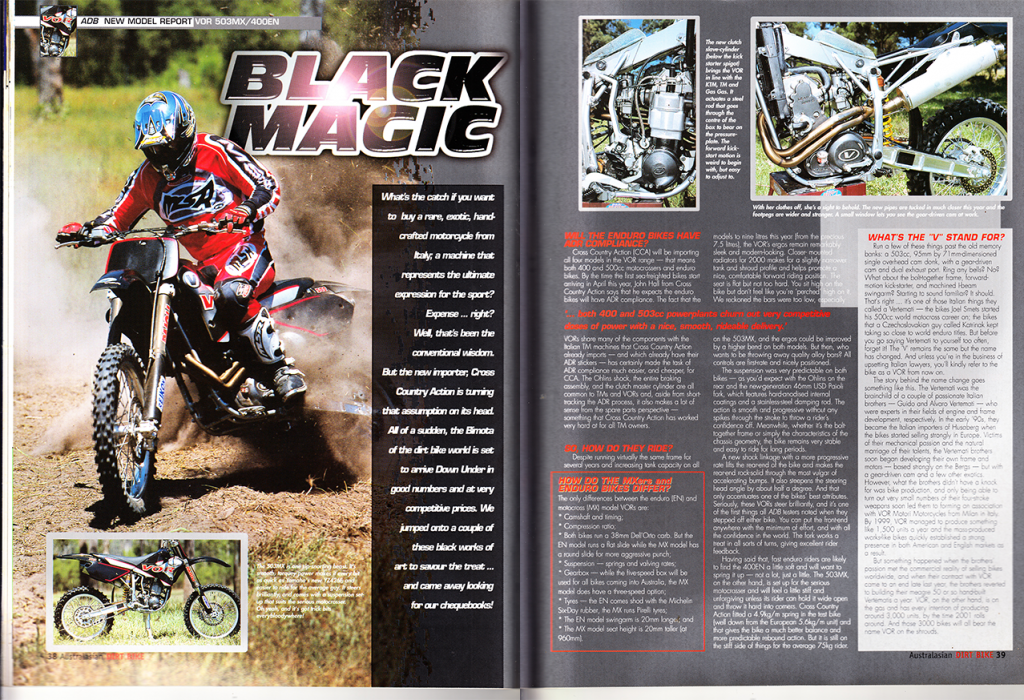The VOR brand was brought in by Cross Country Action, John Hall’s Cessnock-based company that was also the TM importer.
That made for a smaller spares inventory as many of the parts were common to both makes, such as the Ohlins shock, clutch master cylinder and the braking system.
The VOR had some unique features, such as the bolted-together frame and a forward-rotating kickstarter. The air filter sat on the top of the square frame backbone under the nine-litre tank, and the gear-driven camshaft had a small window in the cover letting you see it in operation. The swingarm was made up of three machined forgings that were bolted together and the frame backbone connected to the bottom of the steering-head tube, with a diagonal brace holding the top.
VOR started life as Vertemati, the brainchild of Italian brothers Guido and Alvaro Vertemati who were brilliant engineers but not the best at doing the books. They went into partnership with VOR Motori for mass production but when that contract ended the brothers went back to batch assembly, again using their own surname.
The differences between the two bikes in this test, apart from the capacity, was different camshafts and timing and different compression ratios. Both ran a 38mm Dellorto carb, with a flat slide in the EN and a round one in the MX for more punch. The EN’s swingarm was 20mm longer while the MX had a taller seat. Michelin Six Day rubber was fitted to the EN and Pirelli tyres to the MX and, of course, springs and valving in the suspension differed.
All the bikes destined for Australia were to have a five-speed gearbox but a three-speed was an option for the MX, with the cassette-style gearbox only requiring 10 bolts to be undone for the swap over. ADB’s testers found the EN a little softly sprung and suggested a slight upgrade might be needed but the MX was a little stiff unless the rider was good enough to hold it wide open and throw it hard into corners.
Both were said to steer brilliantly. To quote the test: “It’s one of the first things all ADB’s testers noted when they stepped off either bike. You can put the front-end anywhere with a minimum of effort and with all the confidence in the world. The fork works a treat in all sorts of turns giving excellent rider feedback.”
Power delivery was of the traditional four-stroke style with plenty of rumbling bark, lots of flywheel weight and a heap of engine braking and comparable to equivalent Husabergs. Throttle response off the bottom was a little behind the competition but once up to the 3000rpm mark both engines started to shine right through to about 10,000 were they both signed off, with the 400 having a little more over-rev.
The 503MX was found to be a match for the punchy Yamaha YZ426 and was good for a couple of bike lengths lead by the time both had hit top gear. The VOR was indeed a good bike and, with CCA being the importer, good back up was a given as well. With an $800 to $1000 higher price than the equivalent Husaberg, the other “boutique” brand in the marketplace, the premium VOR machine was considered worth it for the exotic factor that the bikes oozed. Heritage Editor Warren Jack
The Details
WHAT
2000 VOR 503MX/400EN
WHEN
ADB #227, April 2000
PURPOSE
Motocross/Enduro
HOW MUCH
No firm price given, expected to be in the $13,500 range



